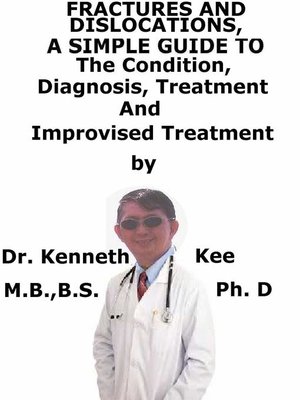Fractures and Dislocations, a Simple Guide to the Condition, Diagnosis, Treatment and Improvised Treatment
ebook
By Kenneth Kee

Sign up to save your library
With an OverDrive account, you can save your favorite libraries for at-a-glance information about availability. Find out more about OverDrive accounts.
Find this title in Libby, the library reading app by OverDrive.



Search for a digital library with this title
Title found at these libraries:
| Library Name | Distance |
|---|---|
| Loading... |
This book Fractures and Dislocations, Diagnosis and Treatment and Improvised Treatment
Fractures are broken bones
Caused by injury and accidents away and at home
Some are due to brittle bones at birth
Or osteoporosis from aging and menopause
Males are affected more than female
Menopause contribute to many fractures
There may severe pain and difficulty in activities
Some if untreated it may result in deformities
Lack of calcium can contribute to fracture alone
Taking more milk and fish help to strengthen the bones
Open fractures may be treated by operation
Close fractures required skills in reduction
X-rays will the confirm the severity
Open fractures may require surgery
Greenstick fracture may just require bandaging
Try to avoid strenuous activities and jogging
A fracture is a break normally in a bone.
Fractures often happen because of car accidents, falls or sports injuries.
Other causes are low bone density and osteoporosis which cause weakening of the bones.
Overuse can cause stress fractures, which are very small cracks in the bone.
Fractures of the bone are classified in two categories:
1. The simple fracture is when the bone is broken in one place.
2. The compound fracture in which the skin is pierced and the flesh and bone are exposed to infection.
If the broken bone punctures the skin, it is called an open or compound fracture.
Types of Fractures
1. A complete fracture is when the bone has broken into two pieces.
2. A greenstick fracture is when the bone cracks on one side only not all the way through.
3. A single fracture is when the bone is broken in one place.
4. A comminuted fracture is when the bone is broken into more than two pieces or crushed.
5. A bowing fracture which only happens in kids, is when the bone bends but does not break.
6. An open fracture is when the bone is sticking through the skin.
A bone may be completely fractured or partially fractured in any number of ways (crosswise, lengthwise, in multiple pieces).
Improvised Fracture Care
Diagnosis of fractures
1. Palpable discontinuity in bone
Palpation of bone is an excellent indicator of bony discontinuity, particularly in the patella, long bones, ribs, and diastasis of the symphysis pubis
2. Deformity
The diagnosis of fracture or dislocation is suspected if there is deformity.
Deformities tend more likely to be present if the patient manifests before there is significant edema or several days later after edema has disappeared, and if the fracture is away from the joints, is angular, is not a partial (e.g., stress, torus) fracture, and is not a compression fracture.
3. Crepitus
Crepitus is a grating sound produced by contact of the broken surfaces with each other and if present is highly indicative of a fracture.
4. Shortening of a limb
This is a credible sign of a long-bone fracture.
Physical diagnosis comprises:
1. Observation,
2. Measurement, and
3. Palpation.
Using these 3 methods, the doctor can diagnose many acute orthopedic disorders without imaging.
Shoulder Dislocation
Diagnosing a shoulder dislocation without a radiograph is fairly simple:
The doctor should feel for the "hole" when the finger falls into the now-empty joint at the glenoid.
If there is any doubt, the doctor should feel the contralateral side of the shoulder.
Other signs are:
1. A flattening of the shoulder,
2. Projection of the elbow with the impossibility of bringing it to the side of the body and, most important,
3. The presence of the head...







